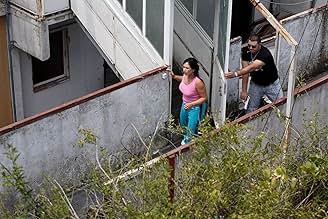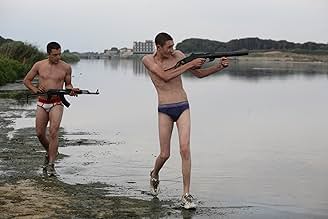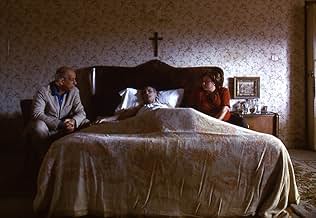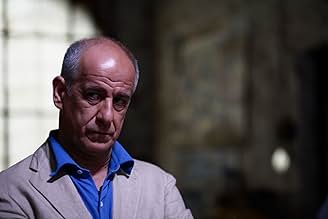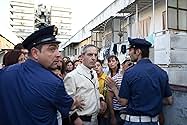VALUTAZIONE IMDb
7,0/10
52.535
LA TUA VALUTAZIONE
Uno sguardo dall'interno sulle famiglie criminali moderne in Italia.Uno sguardo dall'interno sulle famiglie criminali moderne in Italia.Uno sguardo dall'interno sulle famiglie criminali moderne in Italia.
- Regia
- Sceneggiatura
- Star
- Nominato ai 1 BAFTA Award
- 34 vittorie e 42 candidature totali
Salvatore Abbruzzese
- Totò
- (as Salvatore Abruzzese)
Vincenzo Altamura
- Gaetano
- (as Gaetano Altamura)
Recensioni in evidenza
A realistic film about the Neapolitan Mafia, The movie has a documentary touch which i really liked the most, the ending is perfect and real.
A must-see!
Gomorra (2008) ****
Much of Gomorra takes place in and around a crumbling housing project, that in establishing shots looks as if it were a rotting labyrinth pyramid. The very structure of the film's slums serves itself as a visual metaphor for the Camorra crime institution in Naples. It's a bureaucratic shuffle, rivaling a large capitalist corporation, equally ruthless but in different senses of the term. Their products are drugs, extortion, and toxic sludge. Their version of corporate take-over involves murderously shameless acts of extreme violence.
Matteo Garrone deftly directs Gomorra, based on the novel of the same name by Roberto Saviano. It contains a labyrinth plot serving to depict a labyrinth lifestyle. One storyline focuses on a young boy, Toto, who lives in that decaying pyramid, and wants to join up with the gangsters who run it. By the end of the film, his youth will be shattered, and he'll have done things to those around him that would have seemed unthinkable before. He's the ground soldier in the gangster empire.
Don Ciro is an aging money runner, delivering rations to the families of mob prisoners. He gets increasingly caught between the war between factions within the complexes, and before long takes to wearing a bullet proof vest in fear of his own safety.
Roberto is a college graduate, given a high profile job working with Franco, who runs a scheme disposing of garbage and waste from the city by burying it in the countryside - a move that has sent the cancer rate in the countryside through the roof. Roberto must face his own conscious as he becomes more and more aware of the corruption of work.
Pasquale is a talented designer, who's put to work by his friend and boss completing a contract for dresses in less time than he and the workers should like. At great personal risk to himself, he takes an offer from a Chinese factory boss to gives lessons to his workers. The job means crossing the Comorra, so he is hidden in the trunk on the drive to the factory, with a modified hole behind the backseat so he can stick his head out to breath and chat.
The other storyline follows two Scarface-wannabes who long to be the crime bosses of all bosses. They cross the local boss by stealing drugs from dealers, causing trouble, then by stealing weapons from a mob cache, raising Cain. They are knuckle-heads, a couple of kids too stupid to see the truth behind the phony glorification of the gangster lifestyle.
That phony glorification is entirely absent here. Garrone observes his gangsters with an eye of contempt. There is no Robin Hood imagery in Gomorra. It puts on full display the ruthlessness of the gangster culture. It's a gangster as capitalist world, one where turning to killing kids or a woman is looked down upon, but not off-limits.
The film starts off with a fantastic sequence of tanning machines and surprisingly graphic murder, which would lead one to think that they were moving headlong into a Scorsese-like blood bath of macabre. You'd be wrong though. Gomorra is a very patient film, slowly unraveling its stories. It's clearly influenced by the early Italian Neo-Realists, and also has elements that reminded me of the gangster pictures of Jean-Pierre Melville. Garrone shoots in a documentary style with hand-held camera shots. It jumps between its story lines with utmost patience, which might slow down the film's pace more than many would like or are accustomed to. If you do not realize the scope of the Camorra's activity in nearly all facets of commercial and communal life in and around Naples, the connection between the stories may seem unclear. But that's one of the main services of the picture, to show us just how entrenched the mafia has remained in parts of Italy.
Although mob movies are a dime a dozen, Gamorra enters as a gangster epic with freshness. It's a very European film, and as far as gangster pictures go, with its no nonsense documentary style, and only slowly escalating violence and patience it feels like a unique addition to the genre. Gomorra is sure to split, maybe even downright annoy audiences looking for something more conventional. It defies at least most of the genre's clichés, and aims high with its quiet ambitions.
Gomorra won the Grand Prix at this year's Cannes Film Festival, and has been slotted as Italy's official entry into the 2009 Academy Awards for Best Foreign Film.
Much of Gomorra takes place in and around a crumbling housing project, that in establishing shots looks as if it were a rotting labyrinth pyramid. The very structure of the film's slums serves itself as a visual metaphor for the Camorra crime institution in Naples. It's a bureaucratic shuffle, rivaling a large capitalist corporation, equally ruthless but in different senses of the term. Their products are drugs, extortion, and toxic sludge. Their version of corporate take-over involves murderously shameless acts of extreme violence.
Matteo Garrone deftly directs Gomorra, based on the novel of the same name by Roberto Saviano. It contains a labyrinth plot serving to depict a labyrinth lifestyle. One storyline focuses on a young boy, Toto, who lives in that decaying pyramid, and wants to join up with the gangsters who run it. By the end of the film, his youth will be shattered, and he'll have done things to those around him that would have seemed unthinkable before. He's the ground soldier in the gangster empire.
Don Ciro is an aging money runner, delivering rations to the families of mob prisoners. He gets increasingly caught between the war between factions within the complexes, and before long takes to wearing a bullet proof vest in fear of his own safety.
Roberto is a college graduate, given a high profile job working with Franco, who runs a scheme disposing of garbage and waste from the city by burying it in the countryside - a move that has sent the cancer rate in the countryside through the roof. Roberto must face his own conscious as he becomes more and more aware of the corruption of work.
Pasquale is a talented designer, who's put to work by his friend and boss completing a contract for dresses in less time than he and the workers should like. At great personal risk to himself, he takes an offer from a Chinese factory boss to gives lessons to his workers. The job means crossing the Comorra, so he is hidden in the trunk on the drive to the factory, with a modified hole behind the backseat so he can stick his head out to breath and chat.
The other storyline follows two Scarface-wannabes who long to be the crime bosses of all bosses. They cross the local boss by stealing drugs from dealers, causing trouble, then by stealing weapons from a mob cache, raising Cain. They are knuckle-heads, a couple of kids too stupid to see the truth behind the phony glorification of the gangster lifestyle.
That phony glorification is entirely absent here. Garrone observes his gangsters with an eye of contempt. There is no Robin Hood imagery in Gomorra. It puts on full display the ruthlessness of the gangster culture. It's a gangster as capitalist world, one where turning to killing kids or a woman is looked down upon, but not off-limits.
The film starts off with a fantastic sequence of tanning machines and surprisingly graphic murder, which would lead one to think that they were moving headlong into a Scorsese-like blood bath of macabre. You'd be wrong though. Gomorra is a very patient film, slowly unraveling its stories. It's clearly influenced by the early Italian Neo-Realists, and also has elements that reminded me of the gangster pictures of Jean-Pierre Melville. Garrone shoots in a documentary style with hand-held camera shots. It jumps between its story lines with utmost patience, which might slow down the film's pace more than many would like or are accustomed to. If you do not realize the scope of the Camorra's activity in nearly all facets of commercial and communal life in and around Naples, the connection between the stories may seem unclear. But that's one of the main services of the picture, to show us just how entrenched the mafia has remained in parts of Italy.
Although mob movies are a dime a dozen, Gamorra enters as a gangster epic with freshness. It's a very European film, and as far as gangster pictures go, with its no nonsense documentary style, and only slowly escalating violence and patience it feels like a unique addition to the genre. Gomorra is sure to split, maybe even downright annoy audiences looking for something more conventional. It defies at least most of the genre's clichés, and aims high with its quiet ambitions.
Gomorra won the Grand Prix at this year's Cannes Film Festival, and has been slotted as Italy's official entry into the 2009 Academy Awards for Best Foreign Film.
because, at the first sigh, nothing could be new. after many films about gangsters, crimes, South Italy, for the viewer must be clear the entire story. Gomorrah is an exception. for many reasons. first, because it is a real admirable work. then, because it is more than a story about murder and victims but a precise perspective about a large and complex mechanism. not the last, because it is the portrait of society as a collection of masks, sides and silences. and this does it more a support for reflection than entertainment in ordinary sense. the exploration of a huge labyrinth. in the middle of spider web.
The unglamourous reality of the workings of organised crime in Italy are revealed in this grim, thinly fictionalised story. There's no glamour here: just a form of business in which violence is an institutionalised part, a shadow state, in effect, only with a high rate of marginal taxation, a strong line on punishment, and no policy for the common welfare. The reality of how it feels to grow up in such an environment is plausibly conveyed. What we don't see, perhaps unsurprisingly, is too much sign of anyone showing heart; and in consequence, it's a bit hard to get into the story, and care for the mostly unsympathetic characters we meet. 'Gomorrah' isn't a great film; but it is a useful corrective against the myths of Hollywood, albeit one with a rather depressing view into one particular corner of the world.
This is a collection of five stories about people who are touched by the gritty Neapolitan crime world. There is a gang war erupting. Don Ciro is a scared middleman. He is jumped by the other side and forced to take them back to his location. Roberto works in waste management and his boss Franco is dumping toxic wastes. Pasquale works as a high fashion tailor controlled by the mob. He moonlights for their Chinese competitor but it goes wrong. Marco and Ciro are young gangster wannabes. They get in over their heads.
This is a great faux-realistic take on the modern mob. It opens with a bang. I will always remember the waste disposal because of the subject matter. The two youngsters are probably the most compelling characters. There are some ups and downs. It's a disjointed watch. It's a wide-ranging take on the subject and proves to be an effective one.
This is a great faux-realistic take on the modern mob. It opens with a bang. I will always remember the waste disposal because of the subject matter. The two youngsters are probably the most compelling characters. There are some ups and downs. It's a disjointed watch. It's a wide-ranging take on the subject and proves to be an effective one.
Lo sapevi?
- QuizRoberto Saviano got death threats from the Camorra for exposing their activities in the novel and movie, and is now permanently under police protection.
- BlooperAt the beginning of the movie you can clearly see the character named Amerigo belly moving, when his dead body remains on the chair, where he has been having his nails cut.
- Versioni alternativeIn 2020 Matteo Garrone re-cut the movie, reducing the length to 125 minutes.
- ConnessioniFeatured in De wereld draait door: Episodio #4.31 (2008)
- Colonne sonoreHerculaneum
Written by Robert Del Naja and Neil Davidge
Performed by Massive Attack
Additional programming by Euan Dickinson
Courtesy of One Point Six
I più visti
Accedi per valutare e creare un elenco di titoli salvati per ottenere consigli personalizzati
Dettagli
Botteghino
- Lordo Stati Uniti e Canada
- 1.579.146 USD
- Fine settimana di apertura Stati Uniti e Canada
- 5532 USD
- 21 dic 2008
- Lordo in tutto il mondo
- 34.861.529 USD
- Tempo di esecuzione
- 2h 17min(137 min)
- Colore
- Mix di suoni
- Proporzioni
- 2.35 : 1
Contribuisci a questa pagina
Suggerisci una modifica o aggiungi i contenuti mancanti

![Guarda Trailer originale italiano [OV]](https://m.media-amazon.com/images/M/MV5BMjYxMDk3OTItZDQxNC00MTlkLTlkNGYtZWVhMzgzM2M5NWFmXkEyXkFqcGdeQXRyYW5zY29kZS13b3JrZmxvdw@@._V1_QL75_UY281_CR13)


